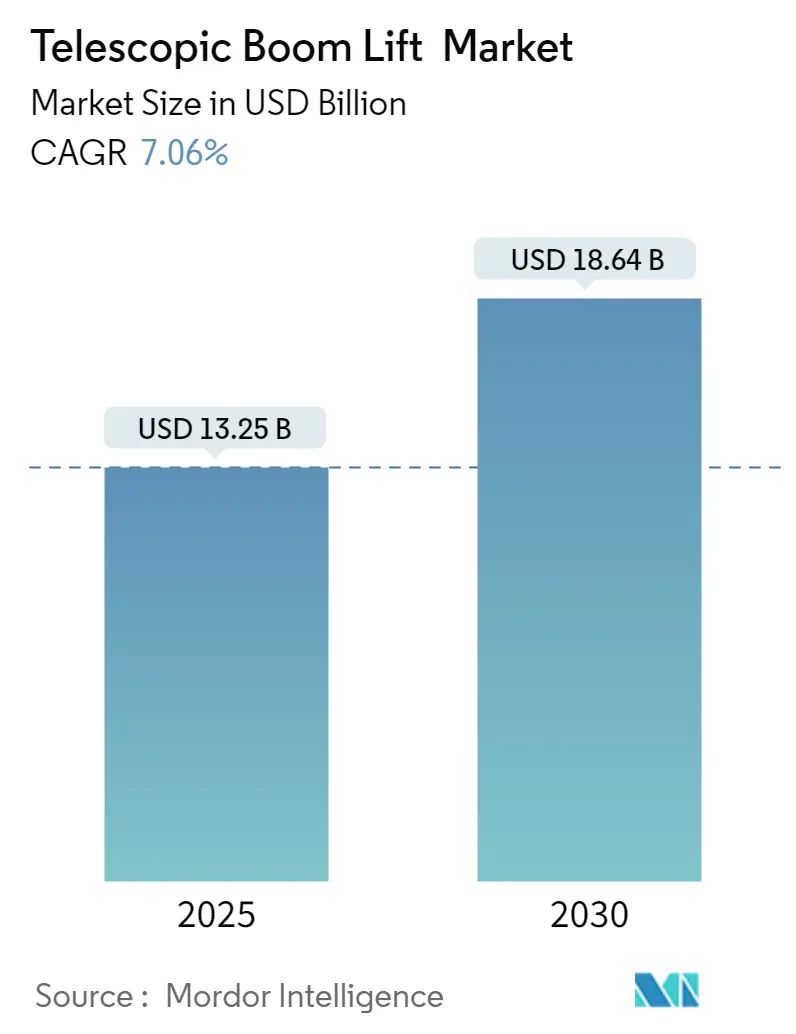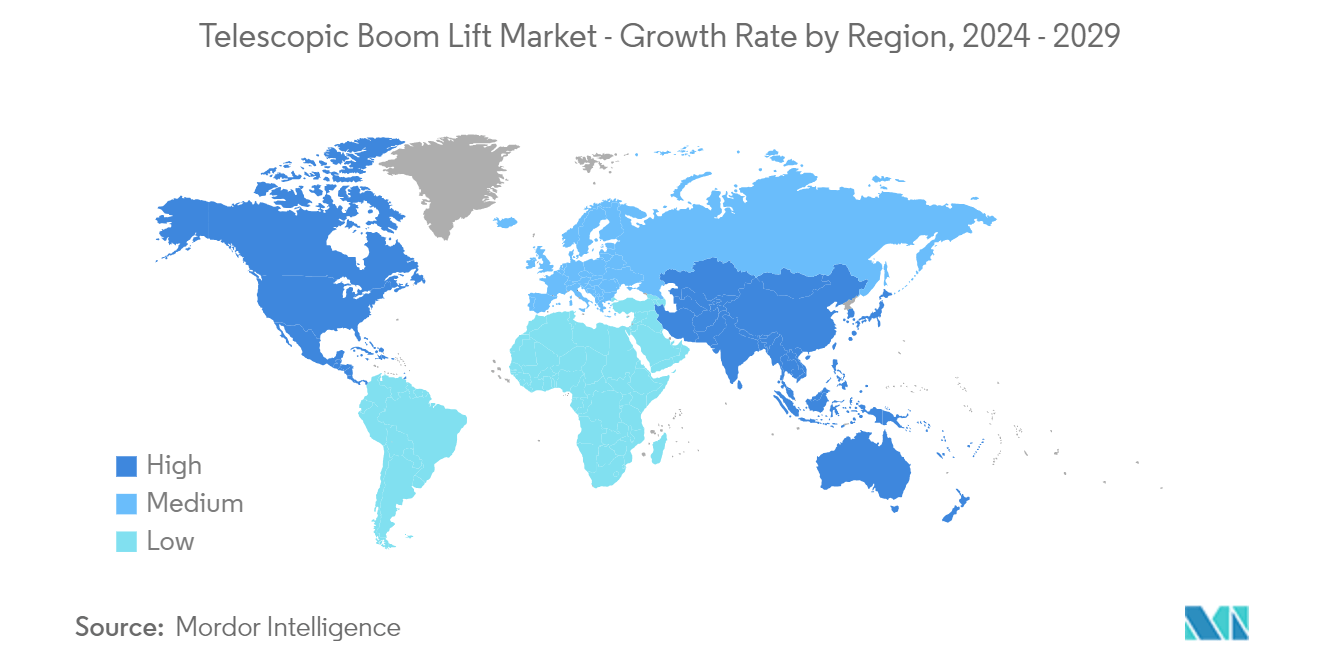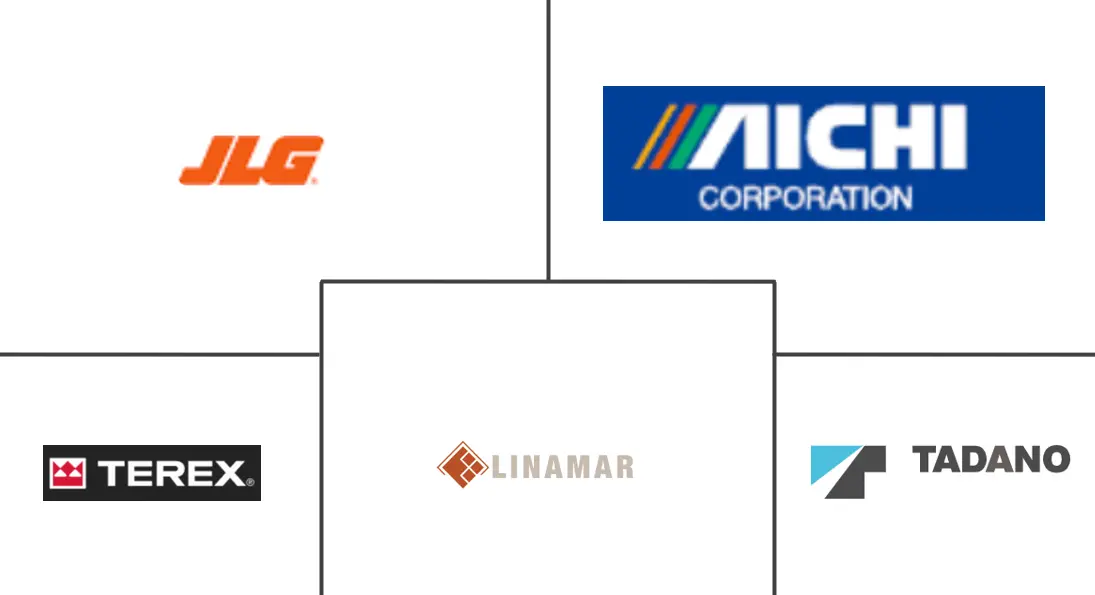Telescopic Boom Lift Market Size and Share

Telescopic Boom Lift Market Analysis by Mordor Intelligence
The Telescopic Boom Lift Market size is estimated at USD 13.25 billion in 2025, and is expected to reach USD 18.64 billion by 2030, at a CAGR of 7.06% during the forecast period (2025-2030).
The telescopic boom lift market is experiencing robust growth, driven by increasing demand for efficient and safe access solutions across various industries. Telescopic boom lifts, known for their long reach and ability to extend horizontally, are essential in construction, maintenance, and industrial applications where height and reach are crucial. This market is characterized by technological advancements, growing urbanization, and heightened safety standards, all contributing to its expansion.
As cities expand and new infrastructure projects increase, the construction industry demands more efficient and versatile equipment. Telescopic boom lifts are particularly valued for their ability to reach high and hard-to-access areas, making them indispensable in constructing skyscrapers, bridges, and large industrial facilities. This trend is especially pronounced in rapidly developing regions such as Asia-Pacific, where urbanization rates are soaring.
The construction industry remains the largest end-user industry for telescopic boom lifts. These machines are vital for structural framing, cladding, and roofing tasks. Their ability to extend both vertically and horizontally allows workers to access challenging locations safely and efficiently. With ongoing developments in global infrastructure, including roads, bridges, and railways, the demand for telescopic boom lifts in this industry is expected to remain strong.
Telescopic boom lifts are also widely used in industrial maintenance and repair tasks. Factories, warehouses, and large industrial plants often require regular maintenance at significant heights. These lifts provide a safe and stable platform for workers to perform tasks such as cleaning, painting, and equipment repairs. The need for regular maintenance in industrial settings ensures a steady demand for telescopic boom lifts.
The future of the telescopic boom lift market is likely to see increased adoption of electric and hybrid models. As environmental concerns and regulatory pressures mount, industries are seeking greener alternatives. Electric and hybrid telescopic boom lifts offer reduced emissions and lower operational costs, making them attractive options for companies looking to enhance their sustainability credentials.
As the market evolves, the adoption of electric models and smart technologies will further enhance their appeal, ensuring sustained demand and innovation in the market.
Global Telescopic Boom Lift Market Trends and Insights
The Electric Lifts Segment Registering the Fastest Growth Rate
The telescopic boom lift market is experiencing a significant shift toward electric lifts, emerging as the segment with the fastest growth rate. This trend is driven by technological advancements, increasing environmental concerns, regulatory pressures, and market demands for more efficient and sustainable lifting solutions.
Electric telescopic boom lifts have benefited greatly from advancements in battery technology and electric motor efficiency. Modern batteries offer longer operational times and faster charging capabilities, making electric lifts more viable for prolonged use in various industrial and construction settings. Innovations such as regenerative braking and energy-efficient drive systems have further enhanced the performance and reliability of these lifts. As a result, electric boom lifts now offer comparable, if not superior, capabilities to their diesel and gasoline counterparts, making them an attractive option for many applications.
Environmental sustainability is emerging as a critical consideration in many industries, and the construction and industrial sectors are no exception. Electric telescopic boom lifts produce zero emissions at the point of use, significantly reducing operations' carbon footprint. This is particularly important in urban areas and indoor environments where air quality regulations are stringent.
Regulatory bodies worldwide are increasingly imposing strict emissions standards and encouraging the adoption of cleaner technologies. Governments and local authorities are offering incentives and subsidies for businesses that invest in electric machinery, further driving the adoption of electric boom lifts. Companies that prioritize sustainability not only comply with regulations but also enhance their corporate image and appeal to environmentally conscious clients.
The market demand for efficient and sustainable solutions is another major driver of the growth in the electric telescopic boom lifts market. Businesses are recognizing the long-term cost savings associated with electric lifts. Although the initial purchase price of electric lifts may be higher, the lower operational and maintenance costs over the equipment's lifespan result in a favorable total cost of ownership. Electric lifts require less maintenance compared to internal combustion engine models, as their number of moving parts is fewer, resulting in a lesser requirement for regular oil changes or fuel system maintenance.
Additionally, the quiet operation of electric lifts is a significant advantage in environments where noise pollution is a concern. This feature makes electric lifts particularly suitable for use in residential areas, hospitals, schools, and other noise-sensitive locations.
The competitive landscape is evolving with significant investments in electric lift technologies, and future prospects remain strong as innovation continues to drive the market forward.

Asia-Pacific Dominating the Market for Telescopic Boom Lifts
Asia-Pacific has witnessed unprecedented industrial growth and urbanization over the past few decades. Countries such as China, India, and Southeast Asian nations are experiencing a construction boom driven by both government initiatives and private sector investments. The construction of high-rise buildings, commercial complexes, and infrastructure projects necessitates using advanced lifting equipment, including telescopic boom lifts, which offer the reach and flexibility needed for such projects.
Governments across Asia-Pacific countries are investing heavily in infrastructure development. Initiatives like China’s Belt and Road Initiative (BRI), India’s Smart Cities Mission, and various infrastructure projects in Southeast Asia are creating massive demand for construction equipment. Telescopic boom lifts are essential for building maintenance, installation of utilities, and construction of tall structures, making them indispensable tools in these projects.
The adoption of modern construction technologies and techniques across Asia-Pacific countries also contributes to the growing demand for telescopic boom lifts. Companies increasingly integrate advanced equipment to enhance efficiency, safety, and productivity. Telescopic boom lifts, known for their ability to reach great heights and navigate challenging terrains, are becoming a preferred choice for construction and maintenance activities.
Leading manufacturers of telescopic boom lifts are focusing on expanding their presence in Asia-Pacific countries. Companies like JLG Industries, Genie (Terex Corporation), and Haulotte are investing in local manufacturing facilities, partnerships, and distribution networks to establish their presence in the growing market.
The presence of local manufacturers and competitive pricing strategies are also contributing to the dominance of the Asia-Pacific market. Local production facilities reduce import costs and offer competitive pricing, making telescopic boom lifts more accessible to a broader range of customers. This is particularly important in price-sensitive markets where cost considerations significantly influence purchasing decisions.
The rising adoption of modern construction technologies and the growing rental market further bolster this trend.

Competitive Landscape
The telescopic boom lift market is consolidated and led by globally and regionally established players. The companies adopt strategies such as new product launches, collaborations, and mergers to sustain their market positions. For instance,
- In February 2024, JCB launched the T65D, a new diesel-powered telescopic boom lift. Powered by a 74-hp JCB 444 EcoMAX engine, it offers 360-degree continuous rotation and can accommodate three workers in the basket throughout its full operating range.
Telescopic Boom Lift Industry Leaders
-
JLG Industries, Inc.
-
Aichi Corporation
-
Terex Corporation
-
Linamar Corporation
-
Tadano Ltd.
- *Disclaimer: Major Players sorted in no particular order

Recent Industry Developments
- November 2023: JLG Industries announced the addition of a new model to its Ultra Series boom lifts. The new 1500SJ is a 150-foot (45 m) telescopic boom lift designed to offer greater work envelope flexibility and superior reach at elevated heights.
- March 2023: Genie, a unit of global lifting solutions specialist Terex Corporation, announced it had commenced the delivery of 135 Genie boom and scissor lifts to Al Majal Al Arabi, a provider of facility management and general maintenance services in Saudi Arabia. These lifts are intended for rapid deployment at the Makkah and Madinah mosque sites.
Global Telescopic Boom Lift Market Report Scope
A telescopic boom lift is a type of aerial work platform used to provide temporary access to elevated and hard-to-reach areas for workers and equipment. It features a telescoping arm that can extend both horizontally and vertically, allowing for precise positioning over long distances. This type of boom lift offers greater height and outreach capabilities compared to other aerial lifts.
The market is segmented by product type, application, technology, and geography. By product type, the market is segmented into diesel lifts, electric lifts, and hybrid lifts. By application, the market is segmented into construction, maintenance & repairs, transportation & logistics, and other applications. By technology, the market is segmented into conventional telescopic boom lifts and articulated telescopic boom lifts. By geography, the market is segmented into North America, Europe, Asia-Pacific, and Rest of the World. The report offers market sizes and forecasts for all the above segments in value (USD) terms.
| Diesel Lifts |
| Electric Lifts |
| Hybrid Lifts |
| Conventional Telescopic Boom Lifts |
| Articulated Telescopic Boom Lifts |
| Construction |
| Maintenance & Repairs |
| Transportation & Logistics |
| Other Applications |
| North America | United States |
| Canada | |
| Mexico | |
| Rest of North America | |
| Europe | Germany |
| United Kingdom | |
| France | |
| Russia | |
| Spain | |
| Rest of Europe | |
| Asia-Pacific | India |
| China | |
| Japan | |
| South Korea | |
| Rest of Asia-Pacific | |
| Rest of the World | South America |
| Middle East and Africa |
| Product Type | Diesel Lifts | |
| Electric Lifts | ||
| Hybrid Lifts | ||
| Technology | Conventional Telescopic Boom Lifts | |
| Articulated Telescopic Boom Lifts | ||
| Application | Construction | |
| Maintenance & Repairs | ||
| Transportation & Logistics | ||
| Other Applications | ||
| Geography | North America | United States |
| Canada | ||
| Mexico | ||
| Rest of North America | ||
| Europe | Germany | |
| United Kingdom | ||
| France | ||
| Russia | ||
| Spain | ||
| Rest of Europe | ||
| Asia-Pacific | India | |
| China | ||
| Japan | ||
| South Korea | ||
| Rest of Asia-Pacific | ||
| Rest of the World | South America | |
| Middle East and Africa | ||
Key Questions Answered in the Report
How big is the Telescopic Boom Lift Market?
The Telescopic Boom Lift Market size is expected to reach USD 13.25 billion in 2025 and grow at a CAGR of 7.06% to reach USD 18.64 billion by 2030.
What is the current Telescopic Boom Lift Market size?
In 2025, the Telescopic Boom Lift Market size is expected to reach USD 13.25 billion.
Who are the key players in Telescopic Boom Lift Market?
JLG Industries, Inc., Aichi Corporation, Terex Corporation, Linamar Corporation and Tadano Ltd. are the major companies operating in the Telescopic Boom Lift Market.
Which is the fastest growing region in Telescopic Boom Lift Market?
North America is estimated to grow at the highest CAGR over the forecast period (2025-2030).
Which region has the biggest share in Telescopic Boom Lift Market?
In 2025, the Asia Pacific accounts for the largest market share in Telescopic Boom Lift Market.
What years does this Telescopic Boom Lift Market cover, and what was the market size in 2024?
In 2024, the Telescopic Boom Lift Market size was estimated at USD 12.31 billion. The report covers the Telescopic Boom Lift Market historical market size for years: 2019, 2020, 2021, 2022, 2023 and 2024. The report also forecasts the Telescopic Boom Lift Market size for years: 2025, 2026, 2027, 2028, 2029 and 2030.
Page last updated on:
Telescopic Boom Lift Market Report
Statistics for the 2025 Telescopic Boom Lift market share, size and revenue growth rate, created by Mordor Intelligence™ Industry Reports. Telescopic Boom Lift analysis includes a market forecast outlook for 2025 to 2030 and historical overview. Get a sample of this industry analysis as a free report PDF download.



